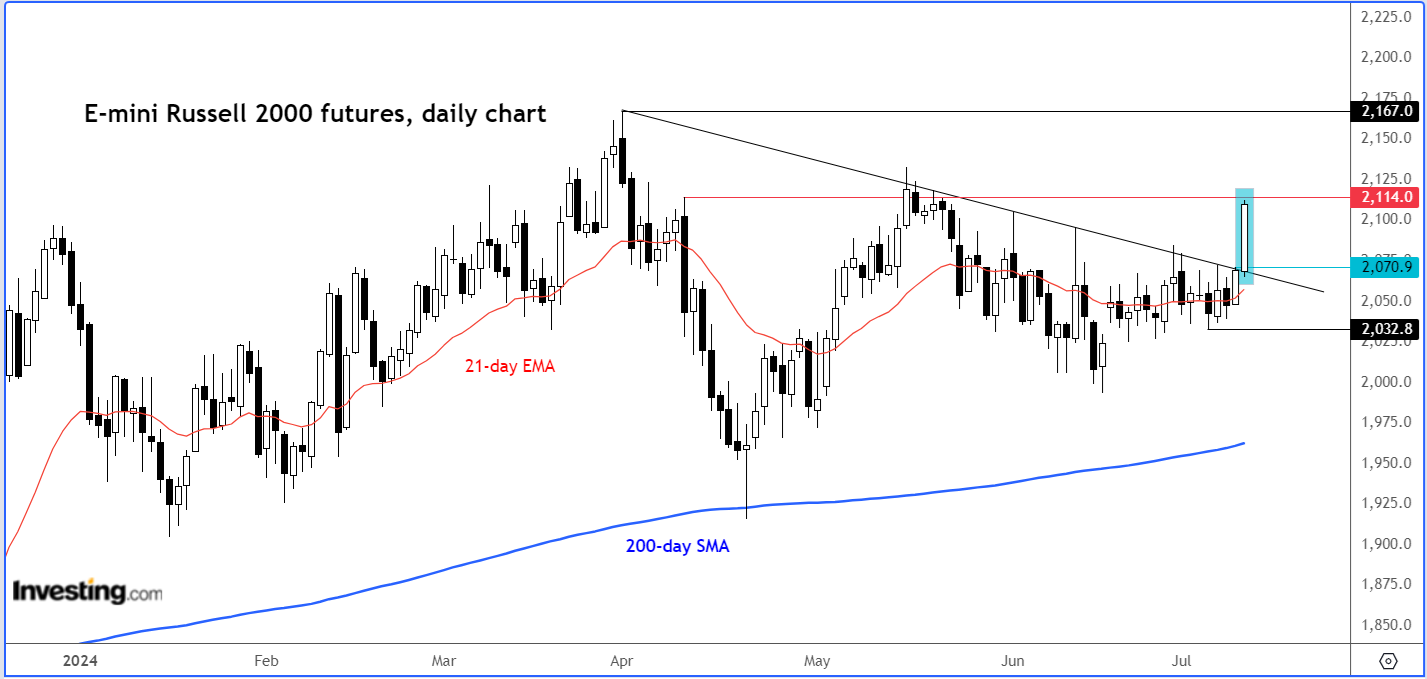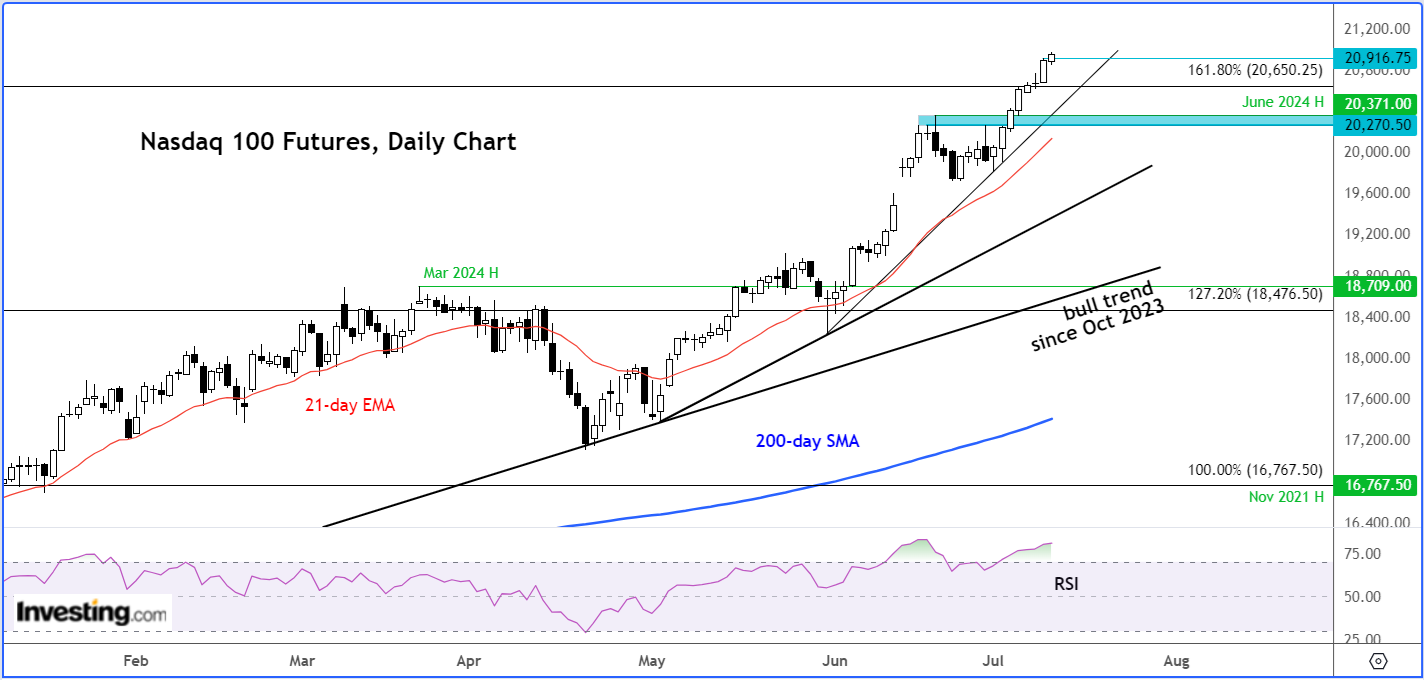- Nasdaq rises to fresh high after CPI came in at 3.0% instead of 3.1% expected
- Small caps set for big rally with Russell 2000 index futures breaking out
- Bank earnings, UoM, and PPI among Friday’s highlights
- Unlock AI-powered Stock Picks for Under $8/Month: Summer Sale Starts Now!
Ahead of the release of today’s US CPI report, index futures were little changed after another tech-fuelled lifted the S&P 500 and Nasdaq 100 to new record highs. Sentiment has remained positive in the sector amid AI optimism and confidence that the Federal Reserve will cut rates.
Confident that the latest inflation would not throw a spanner in the works, these indexes closed at fresh unchartered territories for the sixth straight session, while the Dow Jones Industrial Average also broke out of a recent consolidation zone ahead of the start of the earnings season with banks in focus on Friday.
As it turned, the Consumer Price Index was, in fact, weaker than expected, and this helped to fuel a fresh rally in index futures when the data was released earlier, before profit-taking quickly saw those gains evaporate. But one chart that did hold on to its gains was the Russell 2000 Futures.
The rate cut expectations are on the rise, the dip-buying strategy is likely to remain intact for the time being. With the major indexes at extremely overbought levels, you can take advantage of our cutting-edge AI-powered stock-picking tool ProPicks to identify stocks that outperform the market despite overbought conditions.
By deploying state-of-the-art fundamental data modeling, ProPicks identifies 90+ high-potential stocks every month before they take off. Alongside that, you also get to follow some portfolio strategies that have more than doubled the S&P 500's gains so far this year.
Want to check out all the picks for the Q2 earnings season? Subscribe now for less than $8 a month as part of our summer sale and start beating the market today!
What does today’s CPI data mean for stocks and the Fed?
Unlike the FX markets, the consistent gains in the stock indexes over the past couple of weeks suggest investors were not too concerned about the impact of the US CPI data on the markets. It looks like they had expected inflation to weaken.
CPI was expected to come down to 3.1% year-over-year from 3.3% previously, with a 0.1% monthly rise. However, it eased to 3.0% as the monthly CPI FELL by 0.1% instead of a rise. Core CPI rose 0.1% instead of the expected 0.2%, which meant the year-over-year rate was 3.3% instead of 3.4% expected.
Today’s release of weaker CPI comes after last week's US data didn't quite hit the mark, with the ISM services and manufacturing PMIs and various indicators of the jobs market all disappointing expectations.
Therefore, this latest weaker-than-expected CPI print today strongly indicates that the disinflation process is well and truly on track, helping move inflation toward the Fed’s target and in doing so, keep stock market bulls happy.
Indeed, ahead of the release of today’s inflation data, we had already heard from Federal Reserve Chair Jerome Powell at his two-day testimony. Powell had noted that the economy was no longer overheated, although understandably refrained from committing to a timeline for the next rate cut – albeit adopted a modestly dovish bias while emphasizing the risks.
Expectations of a 25-basis point rate cut in September have been rising and as of yesterday, they had moved to around 70%, up from around 45% a month ago. Today’s weaker CPI report is likely to further push up those expectations.
What else will traders watch this week?
Later in the week on Friday, the spotlight will be on the latest PPI measure of inflation, along with the University of Michigan’s surveys on consumer sentiment and inflation expectations. The University of Michigan's consumer sentiment index has been declining steadily, frequently missing forecasts. Furthermore, the UoM's Inflation Expectations survey dropped to 3.0% from last month's 3.3%.
Persistently lower inflation expectations might result in reduced actual inflation by mitigating the wage-price spiral. At least that is what the stock market bulls will be hoping to see anyway. If instead we see more signs of inflation persisting, then this could undermine stocks, at least temporarily anyway.
Banks to kick off earnings season this week as oil rebounds
Banks will be in focus ahead of the start of earnings season on Friday, which could help fuel a fresh breakout in the Dow Jones Industrial Average. It is also worth keeping an eye on oil prices after they snapped a three-day losing streak.
Further gains could help boost the appeal of energy names in the Dow and the small-cap Russell 200 index. Oil prices rebounded after the latest oil inventories data again showed a sharper-than-expected fall while the EIA revised its demand outlook higher and lowered its production forecast.
The Russell has now broken above its bearish trend line that had been in place since mid-May.

This is clearly a positive development for the small caps, putting the iShares Russell ETF into focus.
Nasdaq reaches extreme levels but no bear signs yet
The Nasdaq is clearly at overbought levels, but no one seems to pay much attention to the Relative Strength Index (RSI) and other measures of momentum. The RSI is at 80.00, some 10 points above the overbought threshold of 70.00. The last time it was this overbought was in mid-June, when the index peaked at 20371, before falling for three days. That dip was short-lived and we broke to a new high and still going strong.

As a result, the Nasdaq futures have surpassed the 161.8% Fibonacci extension level of the last significant drop that took place in November 2021 and ended in October 2022. This level comes in at 20650. With no other obvious upside targets in sight, the rally could easily extend by multiple percentage points before we potentially see a correction.
Short-term support is seen around 20,800, followed by 20650, with a more significant support range coming in between the 20270-20370 area (shaded in blue on the chart) – this being the previous resistance zone in June.
What does it all mean for traders?
As traders, all we can do is identify key support levels to try and buy the dip, any dip, we can get our hands on. We will only look for sell trades when the market breaks a key support level and reverses with some force and conviction. When that happens, it will be obvious. Until then, keep an eye on support levels and continue raising your stops to lock in profit if you are already long.
***
This summer, get exclusive discounts on our subscriptions, including annual plans for less than $8 a month!
Tired of watching the big players rake in profits while you're left on the sidelines?
InvestingPro's revolutionary AI tool, ProPicks, puts the power of Wall Street's secret weapon - AI-powered stock selection - at YOUR fingertips!
Don't miss this limited-time offer.
Subscribe to InvestingPro today and take your investing game to the next level!
Disclaimer: This article is written for informational purposes only; it does not constitute a solicitation, offer, advice, counsel or recommendation to invest as such it is not intended to incentivize the purchase of assets in any way. I would like to remind you that any type of asset, is evaluated from multiple perspectives and is highly risky and therefore, any investment decision and the associated risk remains with the investor.

